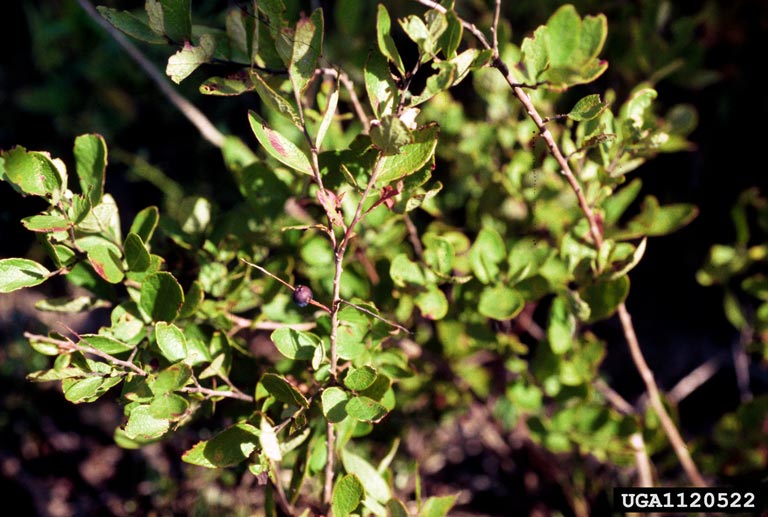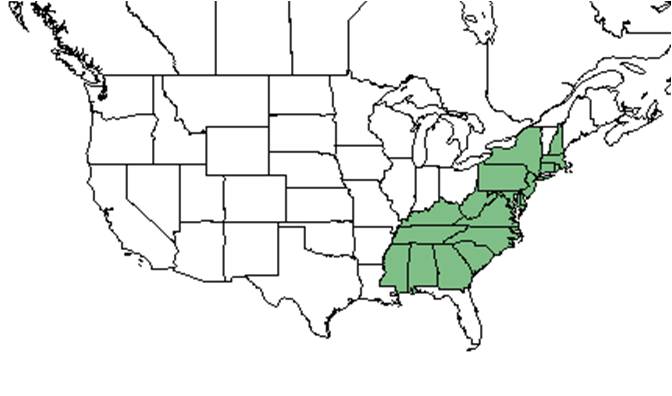Difference between revisions of "Gaylussacia frondosa"
(→Cultural use) |
(→Ecology) |
||
| Line 34: | Line 34: | ||
===Habitat=== <!--Natural communities, human disturbed habitats, topography, hydrology, soils, light, fire regime requirements for removal of competition, etc.--> | ===Habitat=== <!--Natural communities, human disturbed habitats, topography, hydrology, soils, light, fire regime requirements for removal of competition, etc.--> | ||
| − | ''G. frondosa'' has been found in low pine woods, slash pine-gallberry-saw palmetto flatwoods, bogs, upland slopes, and mountaintops.<ref name="FSU"/> It is also found in disturbed areas including along roadsides and annually burned pineland.<ref name="FSU"/> Associated species: ''Serenoa repens, Kalmia, Waccinium'', and ''Azalea''.<ref name="FSU"> Florida State University Herbarium Database. URL: http://herbarium.bio.fsu.edu. Last accessed: May 2021. Collectors:R. Komarek, Sidney McDaniel, R. A. Norris, Bert Pittman, Kathy Boyle, and Herrick Brown. States and counties: Florida: Okaloosa. Georgia: Clinch, Thomas. South Carolina: Chesterfield.</ref><ref name="GEO">Emory University Herbarium accessed using Southeastern Regional Network of Expertise and Collections (SERNEC) data portal. URL: http://sernecportal.org/portal/collections/index.php Last accessed: June 2021. Collectors: R.E. Shanks. States and Counties: Virginia: Giles.</ref> | + | ''G. frondosa'' has been found in low pine woods, slash pine-gallberry-saw palmetto flatwoods, bogs, upland slopes, and mountaintops.<ref name="FSU"/> It is also found in disturbed areas including along roadsides and annually burned pineland.<ref name="FSU"/> Associated species: ''Serenoa repens, Kalmia, Waccinium'', and ''Azalea''.<ref name="FSU"> Florida State University Herbarium Database. URL: http://herbarium.bio.fsu.edu. Last accessed: May 2021. Collectors:R. Komarek, Sidney McDaniel, R. A. Norris, Bert Pittman, Kathy Boyle, and Herrick Brown. States and counties: Florida: Okaloosa. Georgia: Clinch, Thomas. South Carolina: Chesterfield.</ref><ref name="GEO">Emory University Herbarium accessed using Southeastern Regional Network of Expertise and Collections (SERNEC) data portal. URL: http://sernecportal.org/portal/collections/index.php Last accessed: June 2021. Collectors: R.E. Shanks. States and Counties: Virginia: Giles.</ref> ''Gaylussacia frondosa'' is restricted to native groundcover with a statistical affinity in upland pinelands of South Georgia. <ref name=or07> Ostertag, T.E., and K.M. Robertson. 2007. A comparison of native versus old-field vegetation in upland pinelands managed with frequent fire, South Georgia, USA. Pages 109–120 in R.E. Masters and K.E.M. Galley (eds.). Proceedings of the 23rd Tall Timbers Fire Ecology Conference: Fire in Grassland and Shrubland Ecosystems.</ref> When exposed to soil disturbance by military training in West Georgia, ''G. frondosa'' responds negatively by way of absence.<ref>Dale, V.H., S.C. Beyeler, and B. Jackson. (2002). Understory vegetation indicators of anthropogenic disturbance in longleaf pine forests at Fort Benning, Georgia, USA. Ecological Indicators 1(3):155-170.</ref> |
| − | |||
| − | |||
''Gaylussacia frondosa'' var. ''nana'' is frequent and abundant in the Upper Panhandle Savannas community type as described in Carr et al. (2010).<ref>Carr, S.C., K.M. Robertson, and R.K. Peet. 2010. A vegetation classification of fire-dependent pinelands of Florida. Castanea 75:153-189.</ref>--> | ''Gaylussacia frondosa'' var. ''nana'' is frequent and abundant in the Upper Panhandle Savannas community type as described in Carr et al. (2010).<ref>Carr, S.C., K.M. Robertson, and R.K. Peet. 2010. A vegetation classification of fire-dependent pinelands of Florida. Castanea 75:153-189.</ref>--> | ||
| Line 47: | Line 45: | ||
<!--===Seed bank and germination===--> | <!--===Seed bank and germination===--> | ||
<!--===Fire ecology===--> <!--Fire tolerance, fire dependence, adaptive fire responses--> | <!--===Fire ecology===--> <!--Fire tolerance, fire dependence, adaptive fire responses--> | ||
| − | <!--===Pollination | + | <!--===Pollination and use by animals===--> |
| − | |||
<!--===Diseases and parasites===--> | <!--===Diseases and parasites===--> | ||
Revision as of 13:22, 14 June 2021
| Gaylussacia frondosa | |
|---|---|

| |
| Photo by Dwight K. Lauer, Auburn University, Bugwood.org | |
| Scientific classification | |
| Kingdom: | Plantae |
| Division: | Tracheophyta- Vascular plants |
| Class: | Magnoliopsida - Dicotyledons |
| Order: | Ericales |
| Family: | Ericaceae |
| Genus: | Gaylussacia |
| Species: | G. frondosa |
| Binomial name | |
| Gaylussacia frondosa (L.)Torr. & A. Gray | |

| |
| Natural range of Gaylussacia frondosa from USDA NRCS Plants Database. | |
Common names: Blue huckleberry, Dangleberry
Contents
Taxonomic notes
Synonyms: Decachaena frondosa (Linnaeus) Torrey & Gray.[1]
Varieties: none.[1]
Description
A description of Gaylussacia frondosa is provided in The Flora of North America.
Distribution
This is primarily a southeastern Coastal Plain species - it's range extends from southern New Hampshire to southern South Carolina. Less commonly, it's found inland in western New York and Pennsylvania, Virginia, and South Carolina.[1]
Ecology
Habitat
G. frondosa has been found in low pine woods, slash pine-gallberry-saw palmetto flatwoods, bogs, upland slopes, and mountaintops.[2] It is also found in disturbed areas including along roadsides and annually burned pineland.[2] Associated species: Serenoa repens, Kalmia, Waccinium, and Azalea.[2][3] Gaylussacia frondosa is restricted to native groundcover with a statistical affinity in upland pinelands of South Georgia. [4] When exposed to soil disturbance by military training in West Georgia, G. frondosa responds negatively by way of absence.[5]
Gaylussacia frondosa var. nana is frequent and abundant in the Upper Panhandle Savannas community type as described in Carr et al. (2010).[6]-->
Phenology
G. frondosa has been observed to flower in April.[7]
Seed dispersal
This species is thought to be dispersed by consumption by vertebrates. [8]
Conservation, cultivation, and restoration
Cultural use
The fruit can be used to make a sweet and spicy dessert.[9]
Photo Gallery
References and notes
- ↑ 1.0 1.1 1.2 Weakley, A.S. 2015. Flora of the southern and mid-atlantic states. Working Draft of 21 May 2015. University of North Carolina at Chapel Hill, Chapel Hill, North Carolina.
- ↑ 2.0 2.1 2.2 Florida State University Herbarium Database. URL: http://herbarium.bio.fsu.edu. Last accessed: May 2021. Collectors:R. Komarek, Sidney McDaniel, R. A. Norris, Bert Pittman, Kathy Boyle, and Herrick Brown. States and counties: Florida: Okaloosa. Georgia: Clinch, Thomas. South Carolina: Chesterfield.
- ↑ Emory University Herbarium accessed using Southeastern Regional Network of Expertise and Collections (SERNEC) data portal. URL: http://sernecportal.org/portal/collections/index.php Last accessed: June 2021. Collectors: R.E. Shanks. States and Counties: Virginia: Giles.
- ↑ Ostertag, T.E., and K.M. Robertson. 2007. A comparison of native versus old-field vegetation in upland pinelands managed with frequent fire, South Georgia, USA. Pages 109–120 in R.E. Masters and K.E.M. Galley (eds.). Proceedings of the 23rd Tall Timbers Fire Ecology Conference: Fire in Grassland and Shrubland Ecosystems.
- ↑ Dale, V.H., S.C. Beyeler, and B. Jackson. (2002). Understory vegetation indicators of anthropogenic disturbance in longleaf pine forests at Fort Benning, Georgia, USA. Ecological Indicators 1(3):155-170.
- ↑ Carr, S.C., K.M. Robertson, and R.K. Peet. 2010. A vegetation classification of fire-dependent pinelands of Florida. Castanea 75:153-189.
- ↑ Nelson, G. PanFlora: Plant data for the eastern United States with emphasis on the Southeastern Coastal Plains, Florida, and the Florida Panhandle. www.gilnelson.com/PanFlora/ Accessed: 9 DEC 2016
- ↑ Kirkman, L. Katherine. Unpublished database of seed dispersal mode of plants found in Coastal Plain longleaf pine-grasslands of the Jones Ecological Research Center, Georgia.
- ↑ Fernald, et al. 1958. Edible Plants of Eastern North America. Harper and Row Publishers, New York.